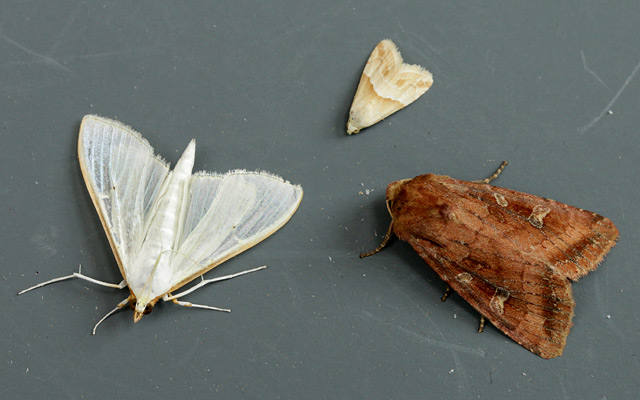The promised rain held for much longer than expected today and allowed for plenty of coverage but, sadly, rewards were scant. A lone Balearic Shearwater was again lingering off the Bill, where 24 Common Scoter, 3 each of Black-headed Gull and Mediterranean Gull, and singles of Manx Shearwater and Curlew passed through or lingered. The only worthwhile report from the land was of 2 Yellow Wagtails over the Bill.
In damp, breezy conditions overnight moth catches were very disappointing, with little interest beyond singles of Buff Footman at the Obs and European Corn-borer at the Grove.
Clay Crest Helcystogramma lutatella - Freshwater Bay, 10th July 2015 © Martin Cade
...we did illustrate this local special last year, but this specimen - caught on our excursion to Freshwater Bay last Friday night - was such a decent, freshly-emerged example that it was just crying out to be photographed. As far as we're aware, lutatella is still only known in the UK from the east side of Portland and a couple of spots on Purbeck, even though it apparently has a rather wide range elsewhere in Europe.
Having given folk a few days to dwell on the matter we thought we ought to revisit Nick Hopper's mystery bird sound we posted a few days ago:
This has generated plenty of comment both at the Obs and via email, with the most popular explanation being a snatch of song from a Wood Sandpiper. Nick had been thinking along these lines but couldn't really find anything that was that close a match, so he consulted Magnus Robb; Magnus's explanation was that it wasn't a vocalisation at all, rather that the sound was 'mechanical' - it was the sound of the wingbeats of a passing bird. Being unhealthily sceptical, we'd queried this explanation with Nick, in particular wondering why there were apparent variations in pitch, as well as posing the question as to whether or not the equipment would/ought to pick up something akin to the Doppler effect as the bird passed by (Dave Chown has raised pretty well the same issues in his comments). Nick is still investigating this whole subject but for the time being he's sent us though a hatful of information to ponder. Here are sonograms from the parts of the mystery recording with the highest and lowest pitches:


...and here's a sonogram of Wood Sandpiper song;
The pink line in each of sonograms is at the same pitch, so it's pretty clear that the mystery sound is considerably lower-pitched than a Wood Sand. The delivery of the sounds is very similar, at 7 notes per second, but the shape of the mystery sound is rounded at the top with a rather convex curve down; the Wood Sand rises, more abruptly comes to a point and then has a straight diagonal line down. It would seem from this evidence that Wood Sand song is certainly out of the equation.
As an example of a recording of wingbeats, this is apparently a Surf Scoter in flight (OK, a pretty random choice as an example, but needs must):
The wingbeats in the mystery recording are at just under 7 per second which apparently puts
it in the large wader/wildfowl category - seemingly an official category in
radar studies. Examples of wingbeat rates in the literature and from Nick's preliminary measurements include:
Grey Heron 2.8
Buzzard
3.5
Shelduck 5
Eider 6.6
Wood Pigeon 6.8
Shoveler 7.2
Wigeon
7.2
Starling 10
Chaffinch 11
Broadly speaking, and as would be expected,
wingbeats get quicker the smaller the bird is; but there are certainly exceptions, with the likes of Goldeneye
coming in at 10, Surf Scoter at 9.4 and Little Bustard at 9. Interestingly, the
Little Bustard shapes on the sonogram are quite similar to the mystery bird and
also waver a bit in pitch, although the beats per second and pitch are much
higher:
Many thanks to Nick for putting in a lot of work on this subject, and we hope we haven't paraphrased away too much of what he's educating us with; also thanks in particular to Dave Chown for his comments.


















































